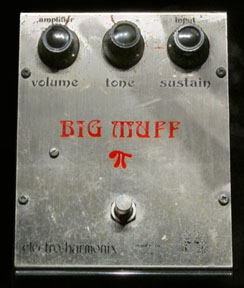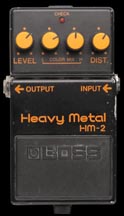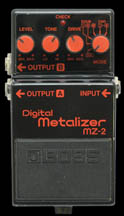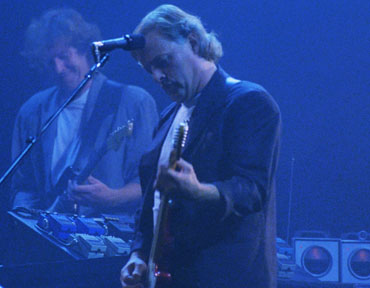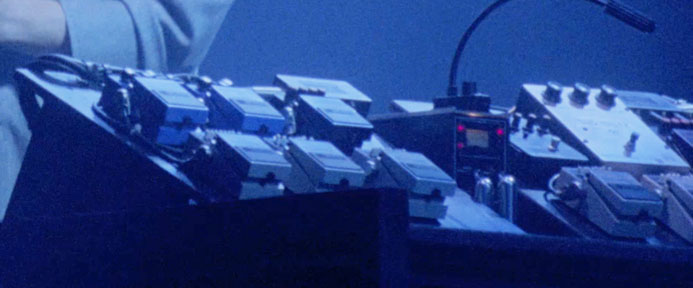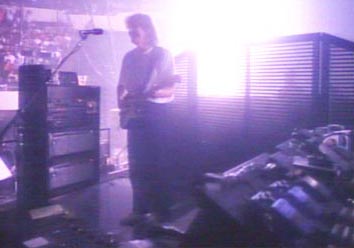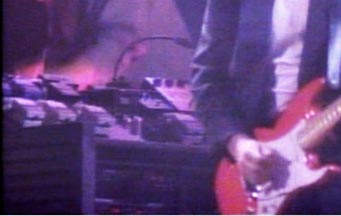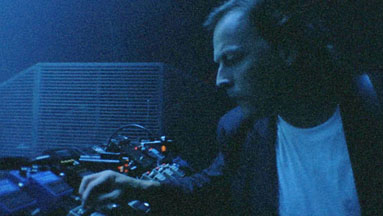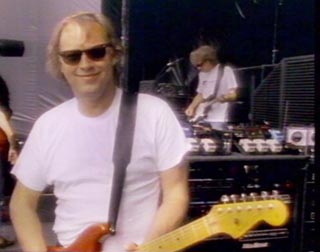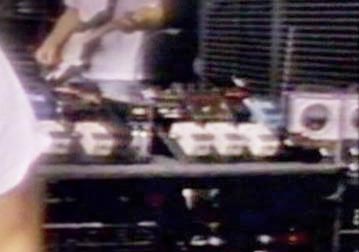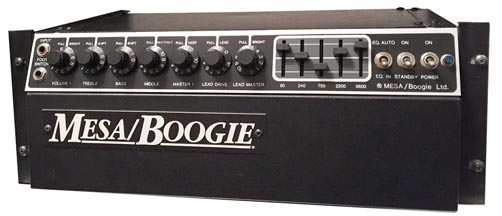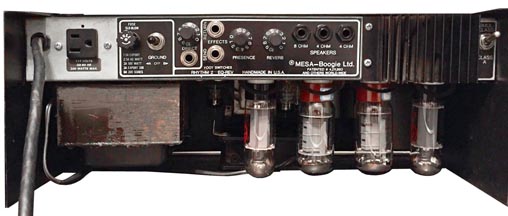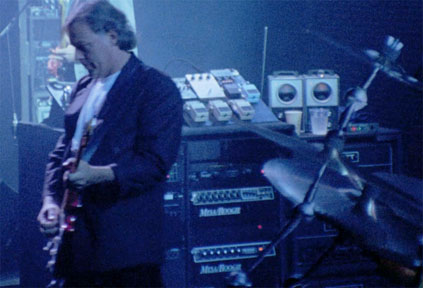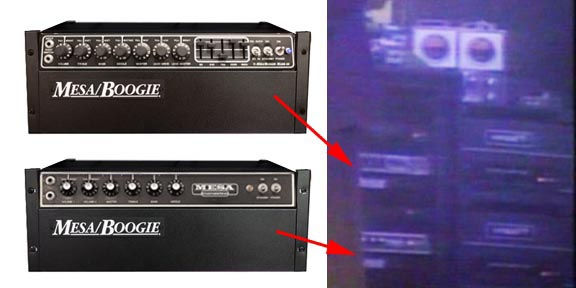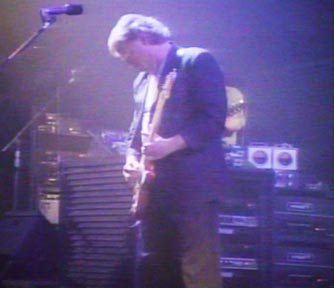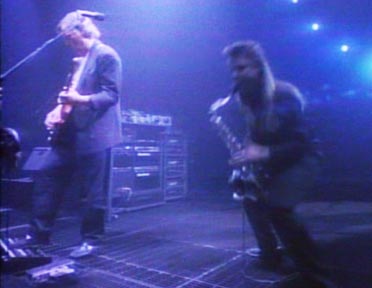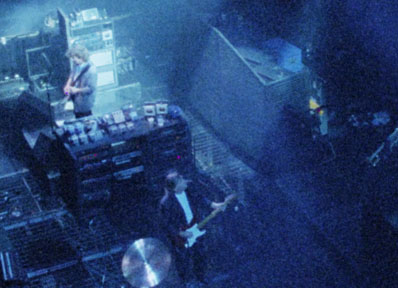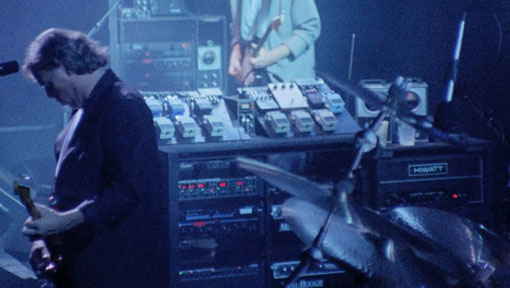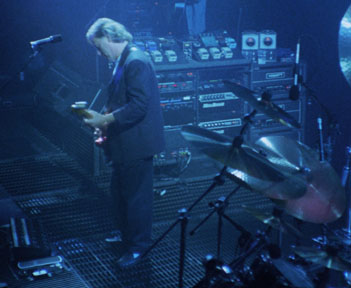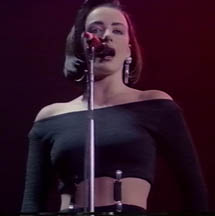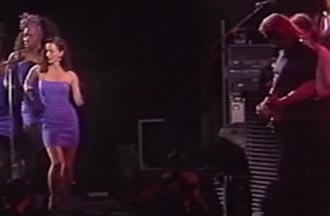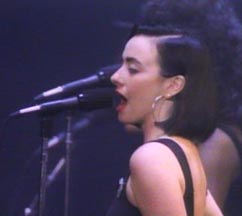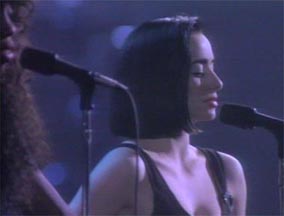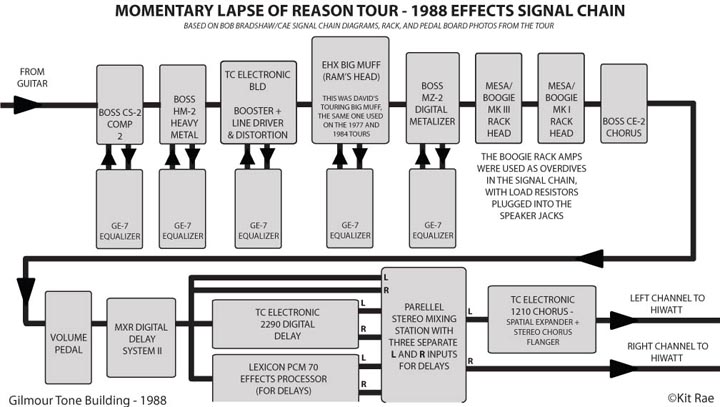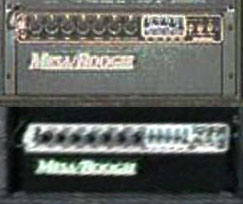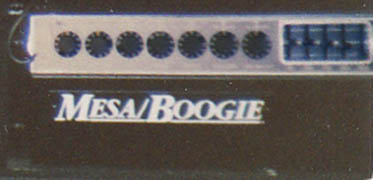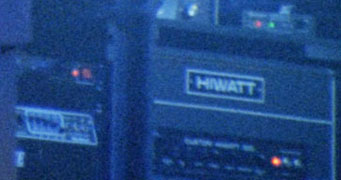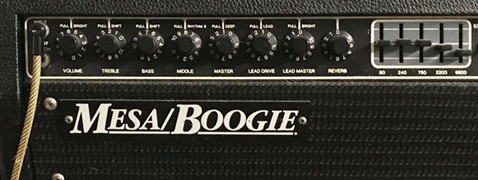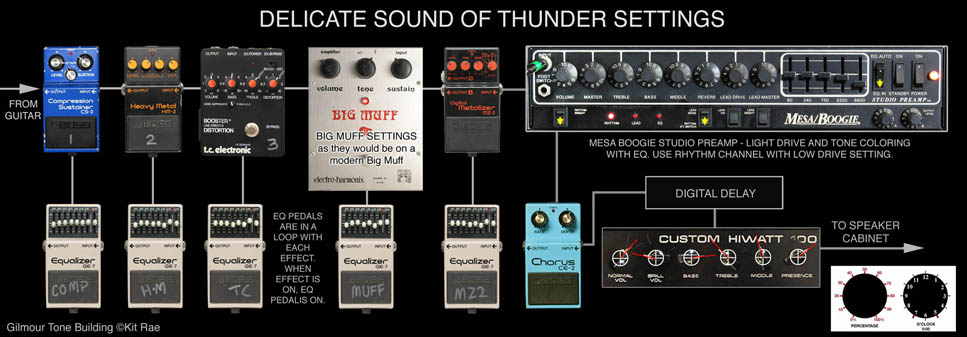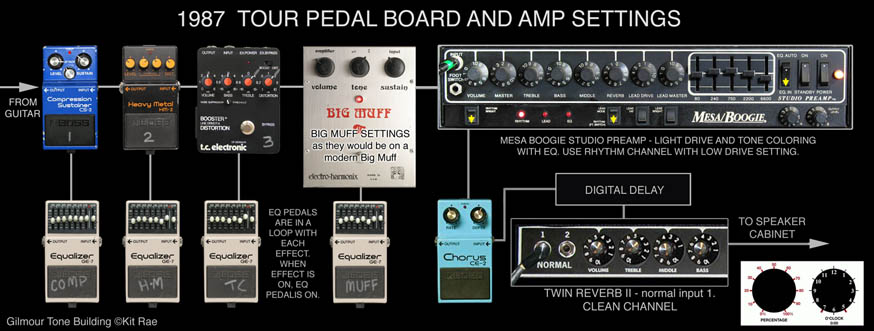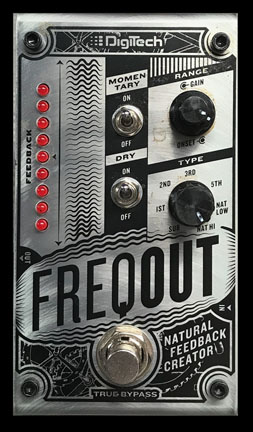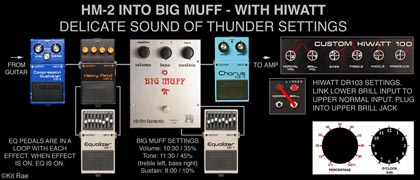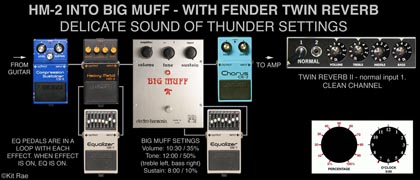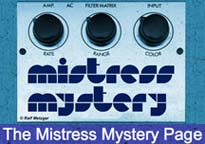NOTE: This website is frequently updated. Last update July 2024.
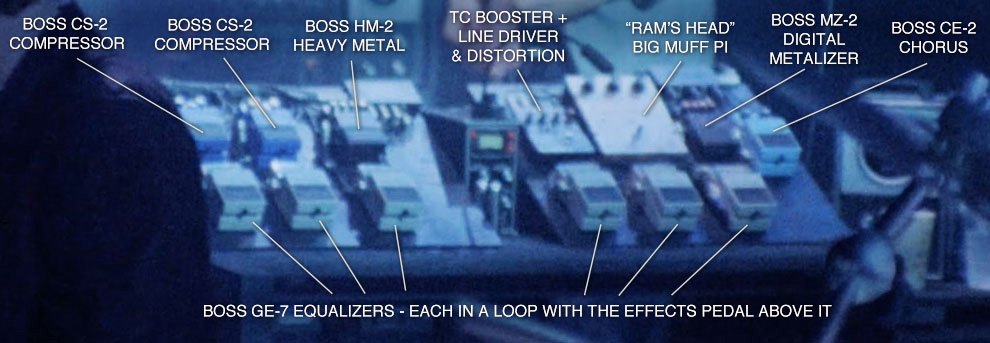
AUGUST 1988 EFFECT PEDALS - A new addition to the board mid 1988 was a Boss MZ-2 Digital Metalizer, which replaced the Cornish P Fuzz. The MZ-2 came out in late 1987 as a replacement for the HM-2, although it did not sound exactly like the HM-2. It blended perfectly with the TC BLD or Mesa/Boogie to create an excellent lead tone. It also blends very well with a BK Butler Tube Driver. All the other pedals that were added between March and April remained on the board.
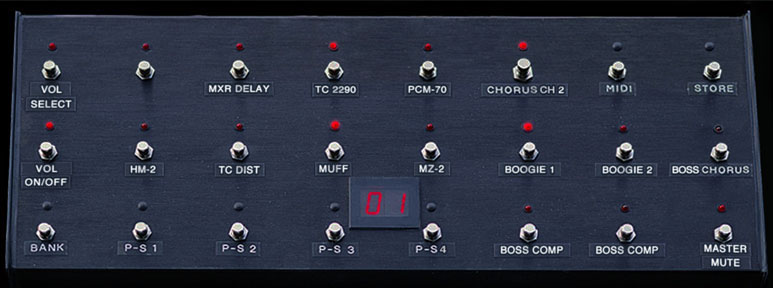
(above) CAE/Bradshaw midi floor switcher, used to select programmed effect patches through the effects routing system or turn individual effects on/off manually
(shown above) - TC Electronic BLD (Booster + Line Driver & Distortion), Gilmour's Electro-Harmonix "Ram's Head" Big Muff Pi , the Boss HM-2, and Boss MZ-2
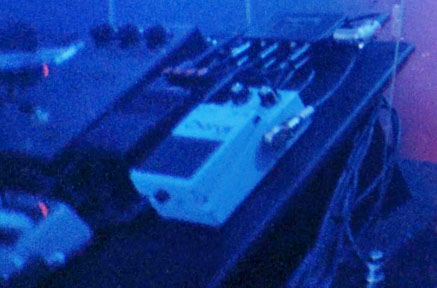
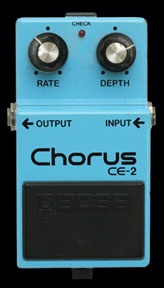
A Boss CE-2 chorus was added to the rig in mid 1988 for songs like Run Like Hell and the outro to Shine On You Crazy Diamond.
Gilmour's settings are shown on the right
(shown above) Snapshots of David's pedals from the Delicate Sound of Thunder film
(shown above) Pedals used in David Gilmour's August 1988 Pink Floyd rig when Delicate Sound of Thunder was filmed
(above) David's rig from August 1988 with a Boss MZ-2 Digital Metalizer added to the board in place of the Cornish P fuzz
1988 RACK EFFECTS - There are no good photos showing the effects in the rack, but it can be seen clearly in the Delicate Sound of Thunder film. I also have a signal chain diagram from Bob Bradshaw confirming the rig effects. A TC Electronics 1210 Spacial Expander + Chorus was added to the rack, used for a light chorus effect in the left channel. It was used for almost every song to add a wider separation to the stereo field. The two SPX-90s used for the heavy chorus effect previously were removed and replaced with a single Boss CE-2 chorus on the pedalboard, going to both the L and R channels. It was used for songs like Run Like Hell and the outro to Shine on You Crazy Diamond.
David's primary delay remained the T.C. Electronic 2290 Dynamic Digital Delay, run in stereo. The MXR Digital Delay System II was also still used. The MXR was a mono delay, but the signal chain diagrams indicate it was split into two channels before the stereo mixer. A Lexicon PCM70 Digital Effects Processor was used for the Binson Echorec style multi-tap delays for Syd's theme in Shine on You Crazy Diamond and the Time intro. It was used in stereo. The Korg DRV 3000 delay was removed.
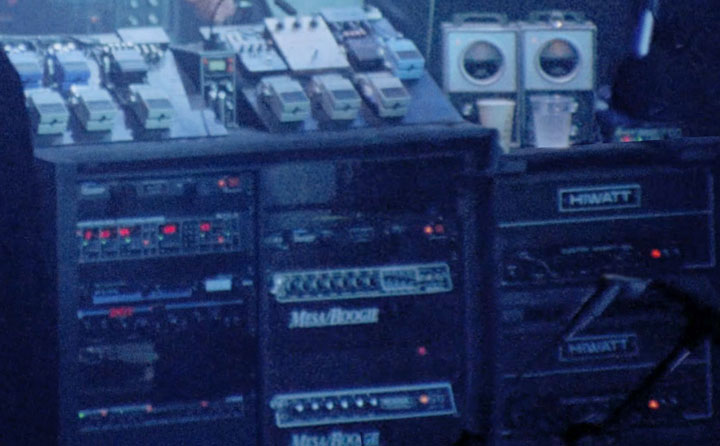
Delicate Sound of Thunder Pedalboard Effects:
Top Row - Boss CS-2 compressor 1 > CS-2 compressor 2 > Boss HM-2 Heavy Metal >
TC Electronic BLD (Booster + Line Driver & Distortion) > Electro-Harmonix "Ram's Head" Big Muff > Boss MZ-2 Metalizer > Boss CE-2 chorus
Bottom Row - six Boss GE-7 equalizers (one in a loop with each effect above it - each GE-7 follows the effect it is paired with in signal chain order)
Rack Effects from top to bottom - left side rack:
• Furman PR8 Power Conditioner
• TC Electronic 2290 Digital Delay - David's primary delay
• Lexicon PCM-70 Effects Processor - used for Syd's Theme in SOYCD and the Time intro
• MXR Digital Delay System II
• TC Electronics 1210 Spatial Expander + Stereo Chorus/Flanger - for light chorus, used in the left channel only
• Pete Cornish VCA voltage controller
Rack Effect from top to bottom - right side rack:
• Furman PR8 Power Conditioner
• Mesa/Boogie Mark III Simul Class amp head - probably a spare for the Mark I below
• Mesa/Boogie Mark I rack head - used as an overdrive in the signal chain
Amplifiers - in rack on far right - each amp head powered a pair of 4x12 speaker cabinets
• Custom Hiwatt AP100 / DR103 - left channel
• • Custom Hiwatt AP100 / DR103 - right channel
• Custom Hiwatt AP100 / DR103 - spare
(above) The TC 1210 Spatial Expander + Stereo Chorus/Flanger was added to the rig in early 1988. The chorus effect was used for the left channel only
(above) The 1985 rack-mount version of the Mesa/Boogie Mark III Simul Class amp head, identical to the one David used in 1987-88. The Mark III featured a five band equalizer to sculpt the tone (80Hz, 240Hz, 750Hz, 2.2kHz, and 6.6kHz). David also used an older Mark I without the EQ in his rack. These amp heads were not used to power a speaker cabinet, but were used in a similar manner as an overdrive pedal, to blend with the Big Muff (the EHX version or P2), or Boss distortions. They were set up as rack effects in the signal chain, utilizing the Direct output on the back. A dummy speaker load was plugged into the speaker jacks. The Boogie rhythm channel could be dialed to sound like a Fender blackface era Twin Reverb.
(above) The Mesa/Boogie Mark III and Mark I rack mounted amp heads with mounting bracket faceplates
Only the Mark I was used for the Delicate Sound of Thunder performances, so the Mark III was probably there as a spare backup.
1988 AMPLIFIERS AND SPEAKER CABINETS - Some time between April and August the three Fender Twin Reverb IIs that powered the speaker cabinets were dropped in favor of David's old standards - three Custom Hiwatt AP100 / DR103 amp heads. Two were used in stereo - of for the left channel and one for the right. The third was a spare. These Hiwatts were modified internally by Pete Cornish to link the high sensitivity normal and high sensitivity brill inputs (each with a 1MOhm resistor) to a third input used for the line in. The fourth input was not used and was fitted with a dummy plug. This had the same effect as plugging a Y cable into each of the the high sensitivity inputs - the bottom 2 on most Hiwatts. Even with the change from Fenders to Hiwatts, the rig still sounded relatively similar to the 1987 leg of the tour. Note - some sources state that an Alembic F2-B was used as the master preamp for this whole rig, but there was no F2-B in this rig. It was not added until 1990.
David stated in early 1988 that he was using two Marshall 4x12" speaker cabinets and two Hiwatt 4x12" cabinets. There are no known photos or video to verify this as the speaker cabinets were hidden behind the stage partition. In back stage video from April 1988 it appears he was still using WEM 4x12 cabs with the Marshall 4x12s, so the change from WEM to Hiwatt cabs must have been made around the time he changed from Twin Reverbs to Hiwatt amps. It is unknown what speakers were in those Hiwatt cabinets, but it is presumed some type of Fane speaker. The Marshall cabs were likely fitted with Celestion speakers as David had used previously, and on later tours. The Marshall cabs were likely the same 1980s era JCM 800 Lead-1960 straight 4x12 cabs that David was using in the mid 1980s.
David's three Hiwatt 100 watt amp heads can be seen in the far right rack. Two were used to power a pair of Hiwatt and Marhsall 4x12 speaker cabinets (in stereo) and one was a spare. The amps had the well known Gilmour mod of linking the normal and bright inputs internally in the preamp stage.
(above) David's rig from August 1988 showing the Hiwatts that replaced the Twin Reverbs
Another essential piece of gear for the Delicate Sound of Thunder, but good luck finding a Rachel Fury for your rig
DELICATE SOUND OF THUNDER SIGNAL CHAIN - Below is the updated signal chain based on Bob Bradshaw's Custom Audio Electronics diagram from April 10, 1988. The original diagram shows a Cornish Muff (P-2), but that changed to a Boss MZ-2 by the time of the August concerts when Delcate Sound of Thunder was recorded. Each GE-7 was in a loop following the effect it was paired with. When an effect was switched on, both it and its corrrsponding GE-7 were used together. A Bob Bradshaw interview about this rig and his original signal chain drawings can be found on the excellent The Tone from Heaven website. The Thanks to John Roscoe and Bob Bradshaw for help with the signal chain.
The MLOR effects signal chain used for the August 1988 live rig used when The Delicate Sound of Thunder live recordings were made
KEY TONE INGREDIENTS - After experimenting with most of the same gear David was using in 1988, I found there were three likely setups for the high gain lead tones, with the primary difference being which distortion pedal was used - either the Big Muff, Boss HM-2, or Boss MZ-2. These setups each have a similar sound, and the way David plays makes it very difficult to determine which was used for which songs. Here are some possible setups.
• Boss CS-2 (optional) > Boss HM-2+GE-7 > Mesa/Boogie rhythm channel set for light overdrive > Delay > Chorus > Hiwatt 100w amp head
• Boss CS-2 (optional) > Big Muff+GE7 > Mesa/Boogie rhythm channel set for light overdrive > Delay > Chorus > Hiwatt 100w amp head
• Boss CS-2 (optional) > Boss MZ-2+GE7 > Mesa/Boogie rhythm channel set for light overdrive > Delay > Chorus > Hiwatt 100w amp head
The confirmed signal chains for the tour indicate the Big Muff + Mesa/Boogie were used for most of the high gain leads. The only confirmed use of the MZ-2 was for the intro to Money. There is no confirmed use of the HM-2, but I suspect it was used for the On The Turning Away solo. A critical component to all of those high gain lead sounds was the Mesa/Boogie amp head, or the "glorified fuzz box" as Bob Bradshaw put it.
A rather expensive overdrive, the tone of the Boogie added that squawky, cocked wah-wah sound that was such an integral part of the DSOT high gain lead tones. It also scoops the mids and deeply scoops the lower mids, while boosting some of the lower frequencies. This creates a huge, dark tone and adds to the range and harmonic content which helps drive the distortion easily into a beautifully saturated feedback. Essentially it was used in a similar manner to the way David later used the B.K. Butler Tube Driver - to blend with the high gain fuzz/distortion boxes in order to smooth out and EQ the tone. Both Boogies were placed after the Big Muff and Boss distortions in the signal chain. Based on the DSOT concert film, only the Mark I Mesa/Boogie was used for the concerts that were filmed.
We only have a few confirmed signal chains from the 1987-89 legs of the tour, but we do have signal chains for every song in the 1990 Knebworth Concert, confirming the Mesa/Booge was used as an overdrive and blended with both the Big Muffs and overdrives. David's backline tech Phil Taylor also confirmed that David used the Muff-into-Mesa combo in an interview.
"David doesn't necessarily use anything exactly as it is, or as you would expect. There are times when he has run a Big Muff into various things such as a Boogie head...or added a graphic equalizer, etc" - Phil Taylor, David Gilmour's gear tech, 2009 Guitar Player
Another possible key for some of those high gain lead tones - in my opinion - was to blend the TC Electronic BLD (Booster + Line Driver & Distortion) into one of the Muffs or Boss pedals to add a crunchiness and sculpt the mid range. It was placed before the distortions in the signal chain. One thing to note about stacking several high gain effects together to create lead tones - like the TC BLD + Muff + Boogie, or TC BLD + Boss distortion + Boogie combination - is that a lot of hiss noise is created. The early version of this rig rig included a Rocktron HUSH II Noise Reduction System, which may have been used for that very problem. The TC BLD also included a built in noise gate circuit, which I'm sure was active if or when the BLD was used with the Big Muff or Boss distortions.
Another important ingrediant was chorus. David's TC 1210 was set for a mild chorus and used in the left channel only, enhancing the stereo field separation between the R and L channels. I think the TC was on for most of the songs, similar to the left channel chorus David used for most of the songs in Pink Floyd's 1994 tour. It is a key part of the sound. The Boss CE-2 chorus was used in both channels for some of the clean and overdrive tones, and had the effect of enhancing the mid range, but I think it was only used for a few songs.
MESA/BOOGIE SETTINGS and SETUP - The Mesa/Boogie used with the Muff or Boss distortions was set to either a slightly dirty tone from the rhythm channel, or a slightly dirty tone from the lead channel. The one photo I have found from early 1988 shows it was set for a slightly dirty clean tone with a bright mid range, but it is difficult to see if the rhythm push-pull pot was engaged. David used the high gain channel input on his MK1 Mesa for The Wall live concerts, and the high gain channel (with the Boss HM-2) for his 1984 tour, and that's the channel (lead channel) I get good results with using my Boogie Mark III with the MZ-2, HM-2 or Big Muff. When I use my Mesa/Boogie Studio Preamp (based on the Mark IIC) instead of the Mark III, the rhythm channel and on board EQ give better results than the lead channel.
The Mesa/Boogies were incorporated into the signal chain like an overdrive effect pedal, something David had been doing since The Wall tour in 1980-81. Each were placed after the high gain Big Muff and Boss distotions in the signal chain. A send from the pedal board went to each Boogie input, through the preamp, power amp, and EQ stage. The Slave output on the back of the Boogie returned the signal to the pedal board before the delays and chorus. Since speaker cabinets were not used with the Boogies, the speaker outs were plugged into 8ohm load resistors to prevent damage to the power tubes and output transformers. Mesa's powerful five band equalizer (80Hz, 240Hz, 750Hz, 2.2kHz, and 6.6kHz) was used to sculpt the tone. In Pink Floyd's 1987 rehearsal photos the EQ was set for a slight mids boost (inverted soft V shape) with reduced bass and highs, but in January 1988 the settings show a downward slope of the highs on the 6.6kHz side. Those settings remained after the switch to the Hiwatt amps, and can be seen in the Delicate Sound of Thunder film from August '88, but only the Mark I was switched on in the filmed performances. The mark III was probably only used as a spare backup to the Mark I at that point.

(above) David's Mesa/Boogie Mark III settings from August 1987, when he was still using Twin Reverb II amps
(above) Mesa/Boogie Mark III settings - left photo from early 1987, left bottom photo from late 1987. Middle photo from February 1988, and right photo from August 1988.
Note that the Mark III was off for the filmed August performances. Only the Mark I was used.
(above) My Mesa Boogie settings for the 1988 tour lead tones
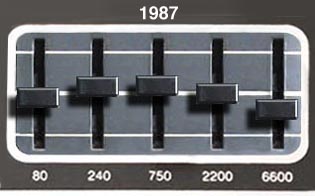
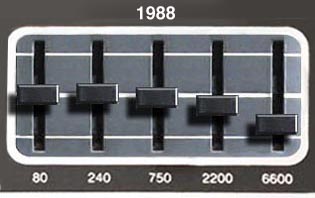
Lowering the highs on the 6.6khz side smoothed out the Big Muff and MZ-2 tone. The bass side was probably cut in
1987 because the Twin Reverb II amps used then were rather bassy compared to the Hiwatts used in 1988.
TC ELECTRONICS BOOSTER + LINE DRIVER & DISTORTION - Or BLD, for short. The BLD was a combination overdrive, clean boost, noise gate, and line driver pedal built by TC in the early 1980s. Players such as Gilmour and Alan Holdsworth used them. It can be used for anything from light overdrive to classic rock distortion. It is now long discontinued and (at the time I wrote this article) somewhat difficult and expensive to acquire. There is a BOOST/DIST switch to select between a clean boost or overdrive distortion, a two-band EQ, distortion control, and a noise gate threshold knob. The line driver circuit helps retain the signal intergrity over long cable runs. It is a very mids-focused overdrive, and rolling down the bass has the unique effect of boosting the mid range. Below is a sound clip noodling around with some different settings on the BLD using an EMG Strat with some delay through a Reeves Custom 50.
![]() TC Electronic Booster + Line Driver & Distortion demo
TC Electronic Booster + Line Driver & Distortion demo
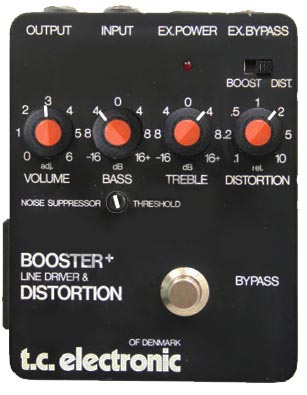
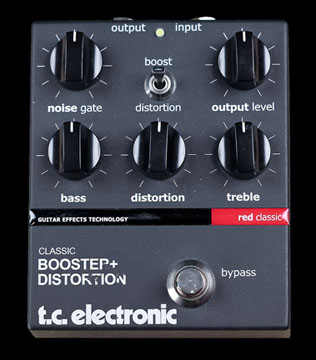

(above left) TC Electronic BLD (Booster + Line Driver & Distortion), or BLD for short. My Delicate Sound of Thunder settings are shown.
(middle) The TC Classic Booster + Distortion is a reissue of the original BLD that was briefly made around 2011.
(right) The PstFX BLD clone of the original TC BLD.
How David used it and for what songs has long been a mystery, but I believe the BLD was his main overdrive for the 1987-88 rig, used for songs like Shine On You Crazy Diamond and Dogs of War. The BLD was also the only overdrive style pedal used in the early versions of David's 1987 rehearsal and touring pedalboard. He had the BLD switched to distortion side, so it was not used as a booster. It is confirmed that it was blended with the Mesa/Boogie for the Dogs of War solos. There is a possibility that it may have also been used to blend with the Big Muff , HM-2, or MZ-2 for some of the high gain solos, but no evidence of that.
The BLD not only drives and blends with those fuzzes perfectly, but it included a noise gate to silence the added hiss created when combining it with a high gain distortion circuit. The pedal itself is not particularly noisy, even at high gain, so I think the noise gate was strictly intended for use when boosting blending with other high gain effects or high gain amps. Other overdrives will work in place of the BLD, like the BK Butler Real Tube Overdrive or Rat, but it is not exactly the same type of sound.
TC briefly reissued the pedal around 2011 as the Classic Booster+Distortion, which sounded identical to the original, but those are even rarer than the original. In 2024 PastFX made a very good clone of the original BLD that sounds practically identical to the original.
Boss GE-7 settings for the Boss CE-2, Boss HM-2, TC BLD, Big Muff, and Boss MZ-2
EQUALIZERS - David has used his trusty Boss GE-7 equalizers on pedalboards since the 1980s to fine tune his guitar effects. For Pink Floyd's 1987-89 Momentary Lapse of Reason tour he started with three GE-7s in 1987 and ended up with six on his pedalboard by late 1988. A GE-7 was used with practically every effects pedal, even the compressors. The settings shown above match what I see on David's pedal board as near as I can determine. I could not see the GE-7 settings used with both Boss CS-2 compressors, so the settings shown are just for the first one.
Each GE-7 was in a loop with its corresponding effect pedal, following each in the signal chain order. When an effect pedal was switched on, was is the GE-7 paired with it, so they worked as one unit. When replicating the Delicate Sound of Thunder or any of the MLOR tour tones with the same effects pedals, it is important to remember that these equalizers were also part of the equation. Also keep in mind the effect and EQ settings were set to work with the voice of the amplifiers and speakers David was using at the time, so these settings may not sound the same depending on the amp and speakers you use.
I think David was fine tuning the guitar tone to sit best in the band mix for specific songs in some cases. In others I think he was trying to sculpt the tone to match certain album tones. You may ask, does equalizing each effect like this really make that much difference? I have tested each of these settings with each effect David used through my Fender bassman, Twin Reverb and Reeves Custom 50 through a Hi-Tone 4x12 speaker cab loaded with Crescendo A speakers and Celestion G12-75 speakers. I can clearly hear the difference each makes, but I would not say they are absolutely necessary to get similar tones.
1988 SONG-BY-SONG SIGNAL CHAINS - There was no visible switching router in the rack for this tour, but the midi floor switcher had a label for each effect in the rig, making it easy to see what effects were on during the songs by looking at the LED lights. Unfortunately there is very little video or photos available showing the midi floor switcher clearly to determine the exact signal chains for every song on the tour. I have only found clear shots of the board for a few songs, listed below. For other songs, refer to the 1990 Knebworth Concert signal chains, which are similar. David swapped the TC 1210 chorus that was used in the left channel of this 1988 rig for another Boss CE-2 chorus in the 1990 rig, but otherwise, the 1988 signal chains are very simiar to the 1990 setups. You can also refer to the the 1994 Tour Signal Chains and substitute a Tube Driver in place of the Mesa Boogie for most leads.
Delay times for most songs can be found HERE. I have included audio clips from Pink Floyd's Nassau 1988 concert with the drums and bass removed for guitar tone reference.
Dogs of War (seen in the re-edited 2019 version of the Delicate Sound of Thunder film) ![]() Dogs Of War isolated Guitar_Nassau 1988
Dogs Of War isolated Guitar_Nassau 1988
....Solos – Comp (Boss CS-2) + GE7 > TC BLD + GE-7 > Mesa/Boogie #1 > Volume pedal > TC 2290 Digital Delay > TC Chorus (left)
Time (audience video) ![]() Time Intro Isolated_Nassau 1988
Time Intro Isolated_Nassau 1988![]() Time Solo Isolated_Nassau 1988
Time Solo Isolated_Nassau 1988
....Intro – Comp (Boss CS-2) + GE-7 > CE-2 chorus > Volume pedal > TC 2290 Digital Delay > Lexicon PCM 70 Delay (for short Echorec style delay)
....Verse - Comp (Boss CS-2) + GE-7 > Mesa/Boogie Studio Preamp > Volume pedal > TC 2290 Digital Delay 1 > TC chorus (left)
....Solo – Big Muff + GE-7 > Mesa/Boogie #1 > Volume pedal > TC 2290 Digital Delay > TC Chorus (left)
Sorrow (based on the Knebworth signal chain)
![]() Sorrow Intro Isolated Guitar_Nassau 1988
Sorrow Intro Isolated Guitar_Nassau 1988![]() Sorrow Outro Solo_Nassau Soundboard_August 20, 1988
Sorrow Outro Solo_Nassau Soundboard_August 20, 1988
![]() Sorrow Solos Isolated_Nassau 1988
Sorrow Solos Isolated_Nassau 1988
....Intro/Outro – Big Muff + GE-7 > Mesa/Boogie Studio Preamp > Volume pedal > TC 2290 Digital Delay 1 > TC chorus (left)
....Solos – Big Muff + GE-7 >Mesa/Boogie #1> Volume pedal > TC 2290 Digital Delay 1 > TC chorus (left)
Shine on You Crazy Diamond (based on the Knebworth signal chain)![]() SOYCD Isolated Guitar_Nassau 1988
SOYCD Isolated Guitar_Nassau 1988
.Intro Solo – Comp (Boss CS-2) + GE-7 >Mesa/Boogie #1> Volume pedal > TC 2290 Digital Delay 1 > TC chorus (left)
...Second Solo – Comp (Boss CS-2) + GE7 > TC BLD + GE-7 > Mesa/Boogie #1 > Volume pedal > TC 2290 Digital Delay > TC Chorus (left)
...Outro Delay Pattern – Comp 1 (Boss CS-2) + GE-7 > CE-2 chorus > Volume pedal > TC2290 Delay > TC chorus (left)
Great Gig In the Sky (based on the Knebworth signal chain)
![]() Slide Guitar Isolated_Nassau 1988
Slide Guitar Isolated_Nassau 1988
....Slide Guitar – Comp (Boss CS-2) + GE-7 > Volume pedal > TC 2290 Digital Delay > TC chorus (left) .
Money (based on the Knebworth signal chain)
![]() Money Isolated Guitar_Nassau 1988
Money Isolated Guitar_Nassau 1988
....Intro Riff – Comp (Boss CS-2) + GE-7 > MZ-2 Metalizer + GE-7 >Mesa/Boogie #1> Volume pedal > TC chorus (left)
....First Solo –Big Muff + GE-7 >Mesa/Boogie #1> Volume pedal > TC 2290 Digital Delay 1 > TC chorus (left)
....Dry Solo –Big Muff + GE-7 >Mesa/Boogie #1> Volume pedal > TC chorus (left)
Comfortably Numb (based on the Knebworth signal chain)![]() Comfortably Numb Guitar Solos_Nassau Soundboard_August 20, 1988
Comfortably Numb Guitar Solos_Nassau Soundboard_August 20, 1988
![]() Comfortably Numb Isolated Guitar_Nassau 1988
Comfortably Numb Isolated Guitar_Nassau 1988
....Intro and Solos –Big Muff + GE-7 >Mesa/Boogie #1> Volume pedal > TC 2290 Digital Delay 1 > TC chorus (left)
Run Like Hell (based on the Knebworth signal chain)
![]() Run Like Hell Isolated Guitar_Nassau 1988
Run Like Hell Isolated Guitar_Nassau 1988
....Comp (Boss CS-2) + GE-7 > CE-2 chorus > Volume pedal > TC 2290 Digital Delay 1 > TC chorus (left)
Yet Another Movie (best guess)![]() Yet Another Movie Guitar Solos_Nassau Soundboard_August 20, 1988
Yet Another Movie Guitar Solos_Nassau Soundboard_August 20, 1988
![]() Yet Another Movie Isolated Guitar_Nassau 1988
Yet Another Movie Isolated Guitar_Nassau 1988
....Solos – Big Muff + GE-7 >Mesa/Boogie #1> Volume pedal > TC 2290 Digital Delay 1 > TC chorus (left)
Another Brick in the Wall Part II (best guess based on the Knebworth and 1994 signal chains)
![]() Another Brick in the Wall Part II Isolated Guitar_Nassau 1988
Another Brick in the Wall Part II Isolated Guitar_Nassau 1988
....Solo – Comp (Boss CS-2) + GE-7 > TC BLD + GE-7 > Mesa/Boogie #1 > CE-2 chorus > Volume pedal > TC 2290 Digital Delay > TC Chorus (left)
Us and Them (best guess based on the Knebworth and 1994 signal chains)![]() Us and Them Isolated Guitar_Nassau 1988
Us and Them Isolated Guitar_Nassau 1988
....Verse – Comp (Boss CS-2) + GE-7 > CE-2 chorus > Volume pedal > TC 2290 Digital Delay 1 > TC chorus (left)
On the Turning Away (best guess)![]() On The Turning Away Solo_Nassau Soundboard_August 20, 1988
On The Turning Away Solo_Nassau Soundboard_August 20, 1988
![]() On The Turning Away Solo Isolated_Nassau 1988
On The Turning Away Solo Isolated_Nassau 1988
....Solo – Boss HM-2 + GE-7 > Mesa/Boogie #1 > Volume pedal > TC 2290 Digital Delay > TC Chorus (left)
One of These Days (best guess based on the 1994 signal chains)
![]() One Of These Days Solo Isolated_Nassau 1988
One Of These Days Solo Isolated_Nassau 1988
....Solos –Big Muff + GE-7 >Mesa/Boogie #1> Volume pedal > TC 2290 Digital Delay 1 > TC chorus (left)
Terminal Frost (best guess)![]() Terminal Frost Isolated Guitar_Nassau 1988
Terminal Frost Isolated Guitar_Nassau 1988
....Solos – Comp (Boss CS-2) + GE-7 > MZ-2 Metalizer + GE-7 >Mesa/Boogie #1> Volume pedal > TC chorus (left)
![]() Wish You Were Here Isolated Guitar_Nassau 1988
Wish You Were Here Isolated Guitar_Nassau 1988
![]() Welcome to the Machine Isolated Guitar_Nassau 1988
Welcome to the Machine Isolated Guitar_Nassau 1988
MY DELICATE SOUND OF THUNDER SETUPS - Since there are very few pictures showing David's settings in this rig, a lot of the signal chains and effect settings I use are pure guesswork. The settings I show work with the amps and speakers I use, but you will need to fine tune the settings to work in your rig if you are using different gear. As noted above, David changed from using Fender Twin Reverb IIs to Hiwatts later in the MLOR tour when DSOT was recorded. I mostly use a Reeves Custom 50 (Hiwatt clone) and a 59 Bassman. Clean amps with lots of headroom work best.
David used EMG SA noisless pickups in his Strats for this tour. These included an SPC control, giving them a slightly hotter, more compressed sound, as well as enriching the mid range and harmonics. David usually had the SPC dialed high for his high gain solos. Many people seem to think the EMGs and SPC were responsible for that unique DSOT tone. While they are a part of the tone mix, they are not a key element in my opinion. A Strat with single coil pickups also works just fine with this setup, preferebly with a hot bridge pickup with a lot of output. David also used Boss GE-7 equalizers in a loop with each effect pedal to fine tune the EQ, but they are not necessary for a small setup.
CHORUS - Chorus is a key ingredient to all of these tones, but not really as prominent as most people think. David used the chorus from a TC 1210 Spatial Expander + Stereo Chorus/Flanger, but only set mildy, and only in the left channel. This was really just to widen the stereo field between the left and right channels. Effectively it was only 50% in the mix. Like Pink Floyd's 1994 tour, I think the TC chorus was an alwasy-on effect for most songs in 1987-88. You can simulate this through one amplifier with a Boss CE-2B chorus, which is basically the old CE-2 with a mix knob. Set it to David's CE-2 settings, and dial the mix back 50%. David also used a CE-2 in the main signal chain running to both channels, but its use was minimal. Like the 1994 Pink Floyd tour, I think he only used it for a few songs, like Syd's Theme and the outro section of Shine on You Crazy Diamond, the delay intro to Another Brick in the Wall, the Time intro, Run Like Hell, and occasionally the unison bend part (when the mirror ball opens up) of the Comfortably Numb outro solos.
DELAY- Delay is another key ingredient to all of these tones. David's primary delay was the TC Electronic 2290 digital delay, which had pristine delay repeats with a little bit of an analog feel. I think he really favored that delay because of its MIDI function that allowed it to store and recall different delay presets from his MIDI floor switcher. I use a TC Nova or Free the Tone Future Factory delay with the highs slightly rolled off the tone. If you use a delay with an LCD showing the time in miliseconds, the delay times for most songs can be found HERE.
DSOT Overdrve Tones - The TC Electronic BLD (Booster + Line Driver & Distortion) was likely used for David's overdrive tones, sometimes combined with the Mesa/Boogie rhythm channel, as used on the Dogs of War solos. It may have also been blended with the muff and Boss pedals, but I have no confirmation of that. Unfortunately the BLD is a rare and expensive pedal, but pedal maker PastFX made an excellent clone called the BLD in 2024. The BK Buter designed Real Tube pedal can mimic similar overdrive tones. The Real Tube was essentially a Tube Driver with a mid range pot added, and the mids control is needed for the DSOT overdrive tones.
DSOT Light Drive and Overdrive Tones - The Boss CS-2 with the TC BLD works for these, or combine those with the rhythm channel Mesa/Boogie Mark III (or Studio Preamp) for the heavier overdrive tones, especially the neck pickups Strat tones. I think the Shine On You Crazy Diamond overdrive tones were the CS-2 + TC BLD, with the Mesa/Boogie rhythm added for the heavy overdrive.
DSOT High Gain Lead Tones - These are the magical DSOT tones that us Gilmour tone chasers want to replicate most from this era. I am certain David used the Mesa/Boogie Mark III amp as an overdrive to blend with the Big Muff and Boss distortions when Delicate Sound of Thunder was recorded in 1988, and according to David's signal router, he did exactly that in the 1990 Knebworth concert. The Mesa is a vital ingredient to the DSOT high gain lead tone in my opinion.
Below is a tone build video showing a few ways to replicate David's typical high gain lead sound. This is the Yet Another Movie lead tone, but it is a similar setup for most of the DSOT high gain leads. I demonstrate the full signal chain with the Big Muff and Mesa/Boogie, and a simpler setup using a PastFX BLD (TC BLD clone) into a Boss MZ-2 Digital Metalizer. The BLD+MZ-2 gets very close to David's live sound. The MZ-2 has long since been discontinued, but it was easy to find them used at the time I wrote this article. I am using a Strat with EMG-SA pickups and the SPC control set to 5. The amps use are a blend of a Reeves Custom 50 through a Hi-Tone Eclipse cab and a Fender 59 Bassman.
Below are examples of the individual high gain pedals alone, then with the Mesa/Boogie rhythm channel added in the signal chain. The Mesa adds some compression and drive, but also smooths out and EQs the tone in a unique way. Strat with EMG-SA pickups and the SPC control set to maximum into a Reeves Custom 50 amp.
Sorrow Solo - Ram's head Big Muff first, then Big Muff + Mesa/Boogie rhythm channel overdrive
Sorrow Solo - Boss HM-2 first, then HM-2 + Mesa/Boogie rhythm channel overdrive
Sorrow Solo - Boss MZ-2 first, then MZ-2 + Mesa/Boogie rhythm channel overdrive
I have not found an acceptable substitute overdrive pedal that works in the signal chain like the Mesa, and buying an old Boogie Mark I or Mark III is an expensive venture for most people, not to mention a hassle to incorporate into a pedal board signal chain due to the need for a dummy signal load on the speaker output.
The next best thing is the 1990s Mesa/Boogie Studio Preamp, which produces a very similar overdrive tone as the Mark III. David himself used it instead of the Mark III in 1990. It is basically the Mesa/Boogie Mark IIC preamp gain stages in a rack effect, and does not require a dummy speaker load. It easily feeds into a pedal board signal chain using an effect loop switcher or loop pedal. It has similar controls as the Mark IIC/C+, with a clean channel that sounds like an early 1970s Fender blackface (or early silverface) amp. The clean channel circuit is basically the same as the Fender Twin Reverb, minus the tube output stage.
I run the Studio Preamp through a loop switcher on my pedal board, placed after the high gain effects, and before the modulations and delays. I leave the Mesa on all the time, and when I want to use it, I just hit the loop switch to bring it into the signal chain, as if I were switching an overdrive pedal on and off. The looper line out goes to the front input of the Mesa, or the Instrument input on the back. I use the MAIN Signal Output on the back of the Mesa to return the signal to the looper. You can use the Recording outputs too, but Mesa EQ'd the tone on those outputs in a way that I do not like. With the rhythm channel engaged, the Master pot is a master volume for the rhythm channel. The main Volume on the left is kind of a gain pot for the rhythm channel, which is why I usually have it on 10 to get some overdrive. The small Output Level (A & B) pots on the front control the overall level being sent form Main Outs A & B (or Recording Outs A & B) back to the pedal board. You can set the Output pot high and the others low, vise versa, or all in between. It just depends on the amount of drive and noise you want. Once you get the level to unity, the Master pot can be used to fine tune it.
Here are my Delicate Sound of Thunder settings for the Studio Preamp, but I have used many variations on these settings that also work. I usually use the rhythm channel, but I have also gotten good results using the lead channel.


There were at least four signal chain combinations I think could have been used for the high gain solos, with certain combinations being used for certain songs, but it probably varied during the tour.
• Boss CS-2 (optional) > TC BLD + GE-7 > Big Muff + GE7 > chorus > delay
• Boss CS-2 (optional) > Big Muff + GE7 > Mesa/Boogie rhythm channel set for light overdrive > chorus > delay
• Boss CS-2 (optional) > Boss HM-2 + GE-7 > Mesa/Boogie rhythm channel set for light overdrive > chorus > delay
• Boss CS-2 > Boss MZ-2 + GE7 > Mesa/Boogie rhythm channel set for light overdrive > chorus > delay
It's unlikely the CS-2 compressor was used with the high gain effects, but it does add more attack, crunch and harmonics to the tone if you are playing at low volume. Sometimes I'll use one to tighten up the sound and give it more punch. As an altenative to the compressor, I prefer to use the TC BLD before the Muff or Boss distortions in each of the signal chains above. I find it adds a bit more gain, compression, and unique EQ sound to the mix. When using the Mesa/Boogie Studio Preamp (instead of the Mark III that David used), I have found running the TC BLD before the Muff or Boss distortions yields tones very close to DSOT.
REPLICATING THE DSOT LEAD TONES - These are just my guesses, but the On the Turning Away solo was probably the HM-2 + Mesa/Boogie combo. Terminal Frost was probably the MZ-2 + Mesa/Boogie combo. Comfortably Numb was probably the Big Muff + Mesa/Boogie setup. I spent several years acquiring similar gear to what was used on this tour and experimenting to find the exact DSOT settings. Below are the settings I use that match what I hear on the official live releases and some of the good bootleg recordings from late 1988. Most of these settings match the ones in photos of David's rig. All of those EQ pedals are not really necessary in a small rig in my opinion, but if you really want to fine tune everything, custom tailor the EQ settings to suit your rig.
If you want to use a Twin Reverb or Twin Reverb II instead of the Hiwatt, like the 1987 leg of the tour, set everything the same as above, but use alternate setting for the Mesa/Boogie Mark III or Studio Preamp as shown below.
The performance of Sorrow from DSOT is mostly taken from the August 23rd 1988 concert. David likely used the same Sorrow setups over and over for each concert. Soundboard recordings from the tour indicate what this lead tone sounded like right from David's speaker cabs. Below is a clip from the soundboard recording on August 20th, followed by the August 23rd DSOT mix, then the 2019 DSOT remix. The various DSOT mixes have obviously been EQd differently and include reverb from the concert hall.
Sorrow solo - August 23rd soundboard, then DSOT version mixed from August 20th performance, then the 2019 DSOT remix.
Below are a few sound clips of my setups to simulate this tone. I am using a Boss GE-7 to EQ the Muff and Boss distortions in a similar manner that David did. I think he used the Big Muff + Mesa for this song, but any of these setups work well. I'm using a Strat with EMG-SA pickups, SPC control set to maximum. Future Factory delay set for 580ms. Reeves Custom 50 (Hiwatt clone) in the left channel and a '59 Bassman in the right channel. A boss CE-2 chorus is in the left channel only, so the effect is not very dominant.
Sorrow Solo - TCBLD + Boss MZ-2 + GE-7 equalizer + Mesa/Boogie rhythm channel overdrive
Sorrow Solo - TCBLD + Boss HM-2 + GE-7 equalizer + Mesa/Boogie rhythm channel overdrive
Sorrow Solo - TCBLD + Ram's Head Big Muff reissue + GE-7 equalizer + Mesa/Boogie rhythm channel overdrive
Below are alternate lead tone setups, without the GE-7 equalizers, and with the CE-2 chorus in both channels so the chorus is more present. Strat with EMG-SA pickups, SPC control set to maximum, TC Nova delay, into a Reeves Custom 50 (Hiwatt clone). The digital delay is set for 540ms, level about 50%, with bright repeats.
Sorrow solo and Outro - TC BLD + Cornish P-2 + Mesa/ Boogie lead channel overdrive
Sorrow solo and Outro - TC BLD + Boss HM-2 + Mesa/ Boogie lead channel overdrive
Sorrow solo and Outro - TC BLD + 1973 Big Muff + Mesa/ Boogie lead channel overdrive
Below are variations of the DSOT Sorrow intro tone. Feedback is a critical element to the intro and outro of Sorrow. As anyone who has played this knows all too well, getting the guitar to feedback at just the right moment is very difficult. How did David get it to feedback consistently? He had the volume very high on stage when playing this part, so much that the guitar would constantly feedback. He would keep the volume backed down slightly on his volume pedal, then increase it when he wanted feedback. I'm using a Strat with EMG-SA pickups, SPC control set to maximum. Future Factory delay set for 580ms. Reeves Custom 50 (Hiwatt clone) in the left channel with a Boss CE-2 in front, and a '59 Bassman in the right channel.
Sorrow Intro - Ram's Head Big Muff only - for reference
Sorrow Intro - TC BLD + Ram's Head Big Muff + Boss GE-7 + Mesa/ Boogie rhythm channel overdrive
Sorrow Intro - TC BLD + Boss HM-2 + Mesa/ Boogie rhythm channel overdrive
The On The Turning Away solo has a slightly different sound than some of the other high gain lead tones. Here is a sound clip with the guitar boosted to the front of the mix from a Nassau Colisseum soundboard recording from August 1988.
For the 1988 DSOT shows I think David was probably using the HM-2 + Mesa/Boogie, but he may have used the Big Muff _ Mesa/Boogie. Either one sounds good. For the 1989 leg of the tour I think he used the Cornish P-2 + Mesa/Boogie. Below are a few sound clips of my setups for this sound. I'm using a Strat with EMG-SA pickups, SPC control set to maximum. Future Factory delay set for 530ms and a little plate reverb from a Ambi Space reverb pedal. Reeves Custom 50 (Hiwatt clone) in the right channel, and a '59 Bassman in the left channel with Boss CE-2 chorus in front.
On The Turning Away solo - Boss HM-2 + GE-7 + Mesa/ Boogie rhythm channel overdrive
On The Turning Away solo - Ram's Head Big Muff + GE-7 + Mesa/ Boogie rhythm channel overdrive
The Time solo is another one where I think David used the Big Muff + Mesa/Boogie overdrive combo. Here is a sound clip of the August 20th soundboard, an August 19th audience recording of the same performance as DSOT, and then the DSOT mix.
Below are a few sound clips of my setups for this sound. The delay is set for 430ms. For the 1988 DSOT shows I think David used the Big Muff + Mesa/Boogie, but later in the tour I think he changed to the Cornish P-2 + Mesa/Boogie.
Time solo - TC BLD +1973 Big Muff + Mesa/ Boogie rhythm channel overdrive
Time solo - TC BLD + Cornish P-2 + Mesa/ Boogie rhythm channel overdrive
Time solo - TC BLD + Boss HM-2 + Mesa/ Boogie rhythm channel overdrive
For the slide guitar solos in One of These Days I think David was using the TCBLD + Big Muff or the Big Muff + Mesa/Boogie. Here is my take on that tone using a Reeves Custom 50 in the left channel and a 59 Bassman in the right. A Boss CE-2 is in line before Bassman. I'm using a 400ms delay from a Free the Tone Future Factory stereo delay, and plate reverb from an FTT Ambi Space to simulate the huge concert hall sound. My lap steel slide guitar is fitted with an EMG-SA pickup and SPC control set to maximum.
One of These Days - Boss CS-2 > TC BLD > EHX Ram's Head Big Muff Reissue > Boss CE-2 chorus in right channel > delay > plate reverb
FEEDBACK IN SORROW - Most fans of this period of Gilmour guitar tones would probably point to the live version Sorrow as one of their favorites. Unfortunately it is very difficult to achieve the trademark feeback sound for the intro and outro of the song at low amp volumes. Even at high volume it can be a bit tricky to get the feeback when you want it, unless you are using a Hiwatt and a 4x12 speaker cabinet. One way around that is the Digitech Frequot. It tracks - and glitches - like a Whammy pedal, so it is not perfect, but with a little practice you can make it work. These settings seem to work best - Feedback type Nat Hi, Gain and Onset knobs around 4:30. Momentary switch set for On. Below is a demo.
![]() Sorrow Feedback Test with Frequot
Sorrow Feedback Test with Frequot
The feedback works great at any volume, as long as you don't change the pitch of the notes too fast or too deeply with tremolo or the whammy bar. Too fast, and the feedback stops. For example - where David's plays the A in Sorrow live, then taps his palm on the tremolo bar a few times before dropping into the E - Tap too deep or too fast and the feedback will stop. The trick is to play the note or chord, hold the Freqout footswitch down and wait for ALL feedback LEDs to light, then use the trem bar. With some practice, you can get it to work, but it is a bit tricky. David actually taps down a whole step when he does it, but the Frequot won't track that deep and fast.
Above is a short demo. For general, non specific feedback, the Frequot is a lot of fun. This is the Natural Hi setting, but all the other settings work good too. In a few places you can hear the feedback sounds like an e-bow.
RUN LIKE HELL - One of the stand out performances from DSOT was Run Like Hell with its extended intro. David had established a certain way of playing this live on his 1984 tour, but the MLOR tour was really when this song became a showstopper, often played as an encore. David's tone had a heavy double tracked ADT sound in 1984 that gave the delay rhythm a thicker and more driving sound than the studio album version. For the MLOR tour that ADT sound was retained, but slightly less dominating. I use two delays in series to replicate that sound. The first delay is 380ms with 8-10 repeats, delay volume almost 100%. The second delay is set for 254ms, 2-3 repeats, delay volume about 35%. Add a compressor, a slight overdrive, and some chorus or Electric Mistress flanger and is rather easy to replicate the DSOT sound.
Run Like Hell Intro - Boss CS-2 + Tube Driver + Deluxe Electric Mistress + Future Factory delay (380ms and 254ms in series) into a Twin Reverb (L) and 59 Bassman (R)
ALTERNATE DELICATE SOUND OF THUNDER SETUPS - It is not necesary to have all that gear shown above to get similar tones. I get very close to the DSOT clean tones just using the Boss CS-2 compressor and Boss CE-2 chorus. I get a really close lead distortion tone using the Boss MZ-2 into a BK Butler Tube Driver. Another really close lead tone is with the HM-2 as the main distortion driver into a Ram's Head Big Muff with the sustain dialed almost off, through a Hiwatt or Fender Twin Reverb. The HM-2 distortion is an excellent driver into a Big Muff for DSOT tones, and this combo is a true blend of the characteristics of both pedals - the bright mid range squawk of the HM-2 distortion and the thunderous low end tone of the Big Muff. The H color knob on the HM-2, which one would assume raises or lowers the treble, is actually tied to the mid range EQ, so the unique mid range is always there. That is part of this pedal's siganture tone, and what makes that particular DSOT lead tone instantly recognizable.
HIWATT SETUP - The HM-2 is the driver and the muff is the bottom end EQ in this combo, so the muff sustain needs to be set very low, around 8:00 - 9:00, so as not to make lows break up and fart out. I suggest starting at zero and dial up until the low E string notes start to break up, then back off slightly. The muff tone circuit is interactive with the sustain, so as you turn the sustain down, turn the tone up the same amount (treble side). I keep mine about 12:00, but adjust until it sounds right on your amp. The H knob on the HM-2, which controls the mid range characteristic, also needs to be adjusted to suit the amp. You may want to start with the Hi at 100%, then dial back until you get the proper mid range between 50% and 100%. I tend to leave it at 100%.
Below are soundclips using the Hiwatt setup shown above. These were played using an EMG-SA pickup equipped Stratocaster into Reeves Custom 50 (Hiwatt clone) with a 540ms delay from the TC Nova, and a lower volume ambient reverb type delay from the Catalinbread Echorec. A Ram's Head Big Muff is shown in the photo above, but I used a Pete Cornish P-1 (a modified Big Muff circuit with a buffer) in these recordings. The SPC control of the EMG Strat was set around 5. Note a standard Strat with standard pickups also sounds perfectly fine with this setup.
On The Turning Away Solo - HM-2 / P-1 Combo into Reeves Custom 50 (Hiwatt clone). Hall reverb added in Garage Band to simulate the concert hall reverb of the DSOT live album version.
HM-2 / P-1 combo, compared to DSOT sound
HM-2 / P-1 combo into Reeves Custom 50, with and without backing track. Non BT sections are just the SM57 mics (one on each speaker)
Below is a soundclip using the Hiwatt setup shown above, but with a Boss MZ-2/Big Muff combo. EMG-SA Strat, CS-2, MZ-2, Big Muff, GE-7, CE-2B churus with 50% mix, Future Factory delay, Ambi Space reverb, into Reeves Custom 50 (Hiwatt clone) and Hi-Tone Eclipse cab.
On the Turning Away solo - MZ-2 / Ram's Head Big Muff combo into Reeves Custom 50.
TWIN REVERB SETUP - This HM-2/Big Muff combo works perfect when running it into a clean Hiwatt DR103 or Reeves, but requires some slightly different settings when using a mid scooped Fender amp, like the Fender Twin Reverb. My settings are shown below.
The clip below is just the MZ-2 into a Twin Reverb. CS-2, MZ-2, CE-2B churus with 50% mix, Future Factory delay, Ambi Space reverb.
Kit’s Secret Guitar, Gear, and Music Page
Guitar stuff, gear stuff, soundclips, videos, Gilmour/Pink Floyd stuff, photos and other goodies.
Copyright Kit Rae.
VISIT MY SWORDS, KNIVES and FANTASY ART WEBSITE www.kitrae.net

.jpg)
